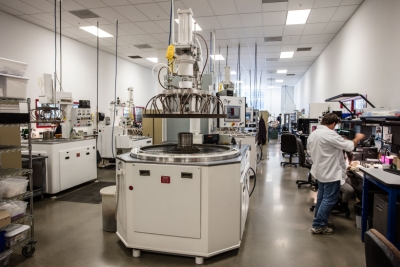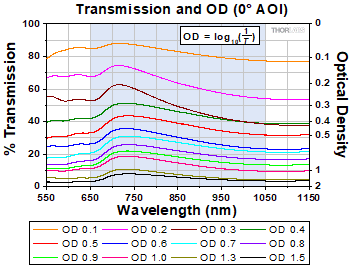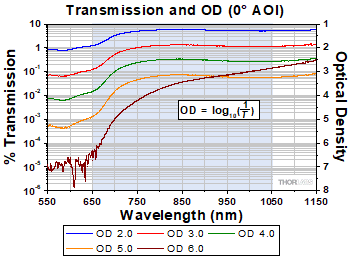ND Filters: Mounted, AR Coated for 650 - 1050 nm

- Mounted Ø25 mm Round Filter
- Optical Densities Ranging from 0.1 to 6.0
- Ideal for Low-Power Applications (<1 W)
NE40A-B
NE50A-B
Application Idea
NE05A-B Mounted
in a DET36A2 Detector

Please Wait
| Table 1.2 Neutral Density Filter Selection Guide | |
|---|---|
| Absorptive | |
| Uncoated (400 - 650 nm) |
Mounted |
| Unmounted | |
| Uncoated (1000 - 2600 nm) |
Mounted |
| Unmounted | |
| AR Coated (350 - 700 nm) |
Mounted |
| Unmounted | |
| AR Coated (650 - 1050 nm) |
Mounted |
| Unmounted | |
| AR Coated (1050 - 1700 nm) |
Mounted |
| Unmounted | |
| Variable | |
| Reflective | |
| UV Fused Silica (200 - 1200 nm) |
Mounted |
| Unmounted | |
| N-BK7 (350 - 1100 nm) |
Mounted |
| Unmounted | |
| ZnSe (2 - 16 µm) |
Mounted |
| Unmounted | |
| Wedged UVFS (200 - 1200 nm) |
|
| Wedged N-BK7 (350 - 1100 nm) |
|
| Wedged ZnSe (2 - 16 µm) |
|
| Variable | |
| Neutral Density Filter Kits | |


Click to Enlarge
Figure 1.1 One of Our Grinding Machines That is Used to Manufacture ND Filters
Features
- Attenuate Light in the Near IR (650 - 1050 nm AR Coating)
- Optical Densities Ranging from 0.1 to 6.0
- Mounted Ø25 mm Filters
- AR Coated to Reduce Back Reflections in an Optical System
- Ideal for Low-Power Applications (<1 Watt)
- Engraved with Coating Range and Part Number
Thorlabs is pleased to offer its most popular mounted absorptive neutral density filters with a broadband antireflection coating for the 650 - 1050 nm range deposited on both surfaces. The high-performance, multilayer broadband B coating deposited on each filter is designed to minimize surface reflections within the 650 - 1050 nm range, thereby reducing the amount of stray light present. These coatings provide an average reflectance that is less than 0.5% over the specified wavelength range when light is normally incident on the filter surface. Typical transmission data may be found by clicking on the blue info icons (![]() ) in Tables G1.1 and G1.2.
) in Tables G1.1 and G1.2.
These filters are mounted in engraved SM1L03 Ø1" lens tubes, which are compatible with a wide range of rigid optomechanical parts such as our cage systems and lens tubes. If desired, a mounted filter can be removed from its housing by unscrewing the retaining ring that secures the filter to the mount. Thorlabs offers a range of spanner wrenches that are an ideal match to these retaining rings. These filters are also available unmounted. The equivalent unmounted filter is listed in the drawing for each mounted filter, accessible through the red docs icons (![]() ) below. Please see Table 1.2 for all neutral density filter options.
) below. Please see Table 1.2 for all neutral density filter options.
Unlike metallic neutral density filters, each absorptive ND filter is fabricated from one member of a family of Schott glasses (see the Specs tab for more information). Each Schott glass has a spectrally flat absorption coefficient. By varying the type of glass used and the thickness of that glass, we are able to produce our entire line of absorptive ND filters from just four types of Schott glass. See Tables G1.1 and G1.2 for detailed information about the average transmission obtained with each of our AR-coated absorptive neutral density filters.
Optical Density and Transmission
Optical density (OD) indicates the attenuation factor provided by an optical filter, i.e. how much it reduces the optical power of an incident beam. OD is related to the transmission, T, by the equation

where T is a value between 0 and 1. Choosing an ND filter with a higher optical density will translate to lower transmission and greater absorption of the incident light. For higher transmission and less absorption, a lower optical density would be appropriate. As an example, if a filter with an OD of 2 results in a transmission value of 0.01, this means the filter attenuates the beam to 1% of the incident power. Please note that the transmission data for our neutral density filters is provided in percent (%).
Please note that these products are not designed for use as laser safety equipment. For lab safety, Thorlabs offers an extensive line of safety and blackout products, including beam blocks, that significantly reduce exposure to stray light.

Click to Enlarge
Figure 1.3 Transmission and Optical Density of -B Coated ND Filters with ODs from 0.1 to 1.5. The values in the legend are the typical optical densities at 633 nm for each optic prior to coating. The blue shaded region indicates the wavelength range for which the AR coating performance is specified.

Click to Enlarge
Figure 1.4 Transmission and Optical Density of -B Coated ND Filters with ODs from 2.0 to 6.0. The values in the legend are the typical optical densities at 633 nm for each optic prior to coating. The blue shaded region indicates the wavelength range for which the AR coating performance is specified.
| Optical Density (OD)a | OD Tolerancea | Substrate | Substrate Thicknessb |
|---|---|---|---|
| 0.1 | ±0.01 | NG11 | 0.6 mm |
| 0.2 | ±0.01 | NG11 | 1.4 mm |
| 0.3 | ±0.015 | NG11 | 2.3 mm |
| 0.4 | ±0.02 | NG4 | 0.7 mm |
| 0.5 | ±0.025 | NG4 | 0.9 mm |
| 0.6 | ±0.03 | NG4 | 1.1 mm |
| 0.7 | ±0.04 | NG4 | 1.3 mm |
| 0.8 | ±0.05 | NG4 | 1.5 mm |
| 0.9 | ±0.05 | NG4 | 1.7 mm |
| 1.0 | ±0.05 | NG4 | 1.9 mm |
| 1.3 | ±0.065 | NG4 | 2.5 mm |
| 1.5 | ±0.08 | NG4 | 2.9 mm |
| 2.0 | ±0.1 | NG9 | 1.4 mm |
| 3.0 | ±0.15 | NG9 | 2.1 mm |
| 4.0 | ±0.2 | NG9 | 2.8 mm |
| 5.0 | ±0.25 | NG9 | 3.6 mm |
| 6.0 | ±0.3 | NG1 | 1.5 mm |
| General Specifications | ||
|---|---|---|
| Diameter | 25.0 mm | |
| Diameter Tolerance | +0.00 / -0.25 mm | |
| Clear Aperture | >Ø20.0 mm | |
| AR Coating Range | 650 - 1050 nm | |
| Reflectance (Average) | <0.5% per Surfacea | |
| Surface Quality | 60-40 Scratch-Dig | |
| Transmitted Wavefront Error (TWE) | <λ/4 (@ 633 nm) | |

Click to Enlarge
Click Here for Raw Data
Figure 2.1 The blue shaded region indicates the 650 - 1050 nm wavelength range over which the AR coating provides <0.5% average reflectance per surface.
| Posted Comments: | |
Gyeongwon Lee
(posted 2025-07-10 16:53:20.367) We have questions for absorptive ND filter
1. Is antireflection layers coated on both sides of filter?
2. Where is the direction of incident light? In case of reflective ND filter, nickel is coated on S1 only, which means light should be transmitted from S1 to S2. EGies
(posted 2025-07-11 11:40:24.0) Thank you for contacting Thorlabs. The filters have an antireflection coating on both surfaces. Since these are absorptive filters, there is not a specified transmission direction. I have reached out to you directly regarding this. Tom de Rooij
(posted 2022-07-14 14:38:10.763) Dear sir/madam,
I have a question about the set of absorptive AR coated Neutral Density Filters, specifically considering the damage threshold. The filters are mentioned as ideal for low power applications. Could you give an indication of the damage threshold in terms of W/cm^2? I couldn't find it easily in the specifications.
Best,
Tom de Rooij cdolbashian
(posted 2022-07-26 03:30:16.0) Thank you for reaching out to us Tom. I have contacted you directly to discuss the damage threshold in terms of your specific light source. We have not done extensive testing for the damage threshold of these optics yet. user
(posted 2019-08-02 10:56:09.283) What are the damage thresholds? YLohia
(posted 2019-08-02 11:38:26.0) Hello, thank you for contacting Thorlabs. Unfortunately, we have not yet performed conclusive damage threshold tests for these optics. These optics are intended for < 1 W beams. That being said, damage thresholds are quite dependent on specific beam parameters such as wavelength, diameter, and average power (peak power, pulse width, rep rate, pulse energy, if applicable). If you would like to find out about the suitability of a particular optic for your application, please email techsupport@thorlabs.com with these parameters. |

 Products Home
Products Home











 Mounted Absorptive ND Filters (B Coated)
Mounted Absorptive ND Filters (B Coated)